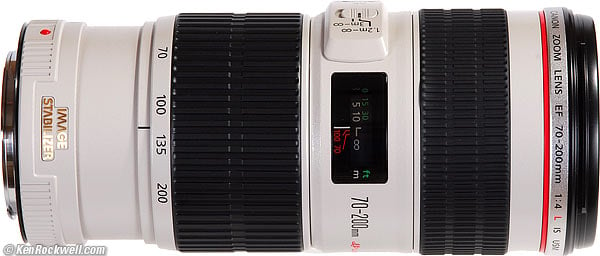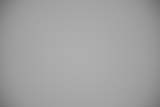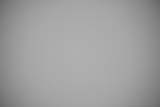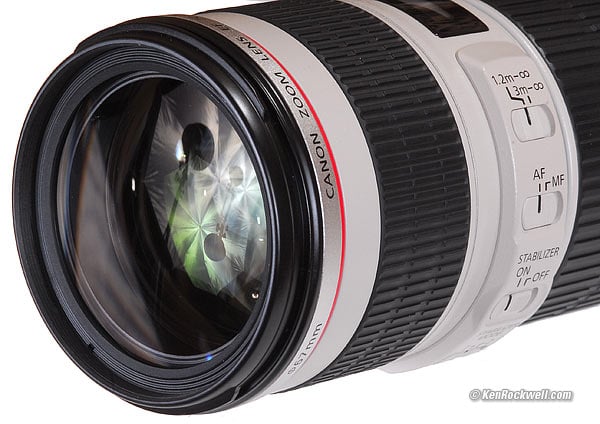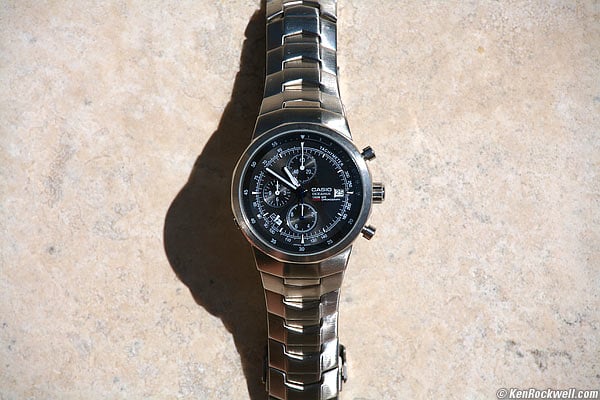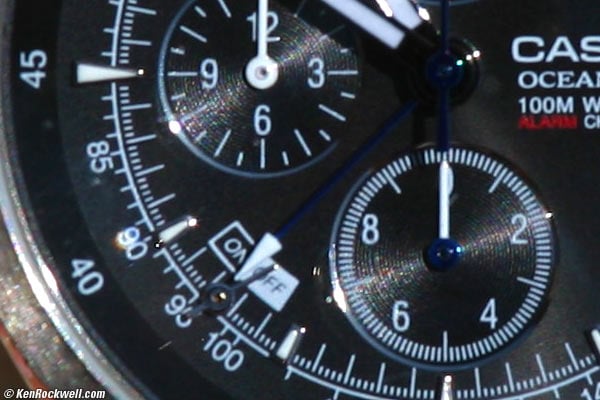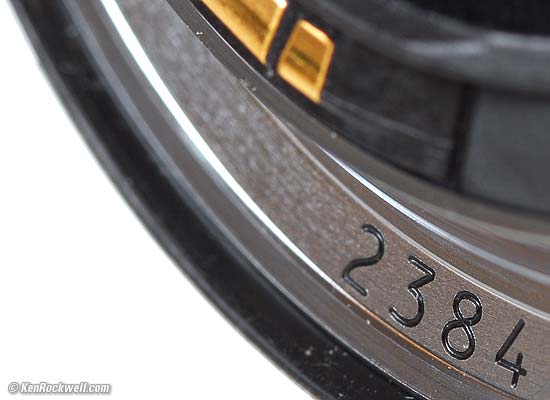Home Donate New Search Gallery How-To Books Links Workshops About Contact
Canon 70-200mm f/4 L IS
Intro Specs Performance Recommendations
Canon EF 70-200mm f/4L IS (covers all formats, 67mm filters, 26.7 oz./756 g, 4'/1.2m close focus, about $1,100). enlarge. I got mine from Adorama; I'd also get it at Amazon, at B&H or at Crutchfield. Adorama pays top dollar for your used gear, especially the non-IS 70-200mm f/4. Using these links to get yours is what helps me keep adding to this site. Thanks! Ken.
NEW: Canon 70-200mm f/4L IS II.
March 2017 Canon Reviews Canon Lenses All Reviews
| Optics: |
|
| Ergonomics: | |
| Usefulness: | |
| Availability: | |
| Overall: |
See also:
Canon 70-200 Comparison Table.
Canon 70-200mm f/2.8L IS II (2010-)
Canon 70-200mm f/2.8L IS (2001-2010)
Canon 70-200mm f/2.8L (1995-)
Canon 80-200mm f/2.8L (1989-1995)
Canon 70-200mm f/4L (1999-)
Introduction top
Intro Specs Performance Recommendations
|
I buy only from these approved sources. I can't vouch for ads below. |
The Canon 70-200mm f/4 L IS is just about the sharpest zoom I've ever used, exceeded only slightly by the 70-200/2.8 L IS II. Not only that, but the ergonomics and operation are flawless, so flawless that I can shoot and zoom with only one hand.
Of all the Canon Teles, as of June 2014, this is one I own and use the most.
Feel free to read this huge review, but if you'd rather be out shooting and have about a grand to spend on a lens, just go get one of these for yourself. If you'd rather spend less, I cover that at recommendations.
Canon currently makes four excellent 70-200mm lenses, not including older models. They make them in f/2.8 or f/4, and with or without Image Stabilization (IS).
I'm addicted to IS because IS lets me leave my tripod at home. Even in broad daylight, IS is required to let me make consistently sharp images at ISO 100 hand-held at longer focal lengths. I wouldn't buy any new telephoto zoom without IS or Nikon's VR, so that narrows us down to the two IS versions, f/4 or f/2.8.
f/2.8 70-200mm lenses are beasts weighing three pounds each. The f/4 versions are only half that. I don't know about you, but I'd rather remove an extra pound and a half from around my neck and keep an extra $700 in my pocket. Of course all four of the current Canon 70-200mm lenses are excellent if you prefer them.
I used to haul my Nikon 80-200mm f/2.8 AF-S everywhere to shoot ISO 50 Fuji Velvia, but now with IS and digital cameras I'd rather have an f/4 lens in exchange for a fraction of the weight. Go lift any f/2.8 telephoto zoom and you'll see what I mean.
You may follow these links to my reviews of the Canon 70-200mm f/4 non-IS and the Canon 70-200mm f/2.8 IS. I haven't reviewed the Canon 70-200mm f/2.8 non-IS version, but you can read about and price it here.
Good News:
1.) Excellent optics; the sharpest zoom I've ever used.
2.) Excellent Image Stabilization.
3.) Excellent one-finger zooming.
4.) Light weight.
Bad News:
1.) It sounds like there is a motor running or something boiling inside when the stabilizer runs. It clicks when it turns off or on.
2.) Other than that, this is a perfect lens. Pay your $1,050 and be happy.
Specifications top
Intro Specs Performance Recommendations
Name
Canon calls this the Canon Zoom Lens EF 70-200mm f/4 L IS USM.
EF: Electronic Focus. All modern Canon lenses focus with a motor in the lens.
L: Expensive as L. more at Canon L Series Lenses.
IS: Image Stabilization, which means no tripod needed except at night. See Why IS Matters.
USM: Ultra-Sonic Motor: The focus motor operates silently.
Focal Length
70-200mm.
Used on a 1.3x camera it gives angles of view similar to what a 88-251mm lens would give on a 35mm film camera.
On a 1.6x camera it gives angles of view similar to what a 114-324mm lens would give on a 35mm film camera. See also Crop Factor.
Optics
20 elements, 15 groups, including a UD glass element and a fluorite element. These special materials help reduce color fringing.
Internal focus and internal zoom; nothing moves externally.
Diaphragm
8 blade rounded. It's circular through f/8 and octagonal from f/16 up.
Stops down to f/32.
Filter Size
67mm.
Close Focus
4' or 1.2m from the image plane (the back of the camera), marked.
Maximum Reproduction Ratio
1:4.8.
Infrared Focus Index?
YES, for 100mm and 70mm
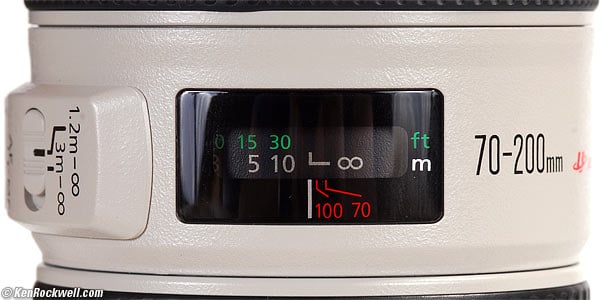
Canon 70-200mm f/4 IS focus window
Size
2.990" diameter x 6.77" extension from flange (75.96 x 172.0mm), measured.
Weight
26.668 oz. (756.05 g), measured, naked.
Hood
ET-74, included. (same hood as non-IS 70-200mm f/4 L)
Case
LP1224, included. (same case as non-IS 70-200mm f/4 L)
Announced
24 August 2006.
Available since
November 2006.
Price, USA
$1,100, March 2017 ~ August 2018.
$1,200 after rebate, July 2014.
$1,149 after rebate, May 2014.
$999 after rebate, Christmas 2013.
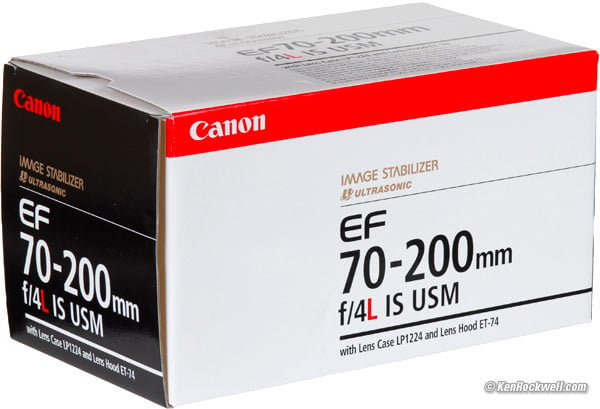
Performance top
Intro Specs Performance Recommendations
Autofocus Bokeh Color Color Fringes Construction Distortion
Ergonomics Eyeblow Falloff Film Filters Flare Macro
Serial Number and Date Code Sharpness Sunstars IS Zooming
The Canon 70-200mm f/4 L IS is one of those lenses that just works and delivers great images without getting in your way.
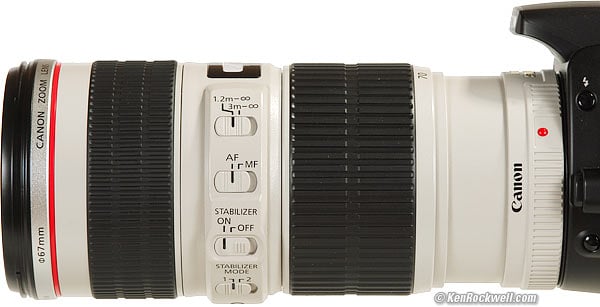
Canon 70-200mm f/4 L IS side view on a Rebel XTi
The Canon 70-200mm f/4 L IS has a lot of slide switches. They are recessed and unlikely to get knocked, although pros often jam in toothpicks and tape them over to be sure.
Personally I could do without the focus range limiter in order to have fewer switches from which to select when operating them by feel. I also wish that Canon provided autofocus lock pushbuttons as my Nikon 80-200mm AF-S and the Nikon 70-200mm f/2.8 VR have.
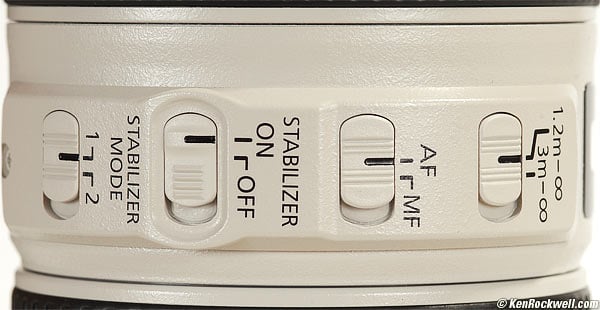
Canon 70-200mm f/4 L IS switches
Stabilizer mode 1 is normal. Mode 2 is only for moving objects, especially women enjoying the good life in a Mercedes SL500, as shown in the illustration in the instruction book. More at the Image Stabilization section.
Focusing back to Performance or back to Introduction.
The auto and manual focusing is excellent. It's fast, easy, accurate and never gets between you and a great photo.
What Moves
NOTHING. All the focusing happens inside the Canon 70-200mm f/4 L IS, so nothing moves or extends externally.
Focus Distance Scale
Yes.
Depth of Field Scale
NO.
AF Speed
AF speed is the usual Canon hallmark of nearly instantaneous focus. It's as fast as my own eyes.
Ease of Manual Focusing
Perfect; just grab the ring at any time.
There's no need to move an AF/MF switch unless you want to stay in manual focus.
When you do grab the ring during AF, focus stays where you set it until you lift off and re-tap the shutter button to restart autofocus.
Autofocus Accuracy
AF accuracy and consistency is excellent on my 5D and very good on my Rebel XTi.
I get perfect focus at f/4 at all focal lengths and distances on my Canon 5D, except at 200mm at f/4 at the closest focus distance where it sometimes will focus a half inch (1cm) behind the intended subject. I'd never see this except that I was deliberately testing this, and it's perfect at f/5.6.
Autofocus is less consistent on my Rebel XTi, which as I've seen from previous lens tests is about par for the course with my XTi.
Focus Breathing
Breathing is a motion picture term which refers to what happens as you pull (change) focus from near to far. I list this for people putting these lenses on their Canon XL-1s for shooting video.
The Canon 70-200mm f/4 L IS increases magnification as the focus is pulled closer.
Bokeh back to Performance or back to Introduction.
Bokeh is very neutral, with soft edges to the blur circles. No surprises here.
Lateral Color Fringes back to Performance or back to Introduction.
The Canon 70-200mm f/4 L IS is approved by the PPLFPA, Professional Patio and Lawn Furniture Photographers' Association, with a grade of "A." Go ahead and knock yourself out, there is no significant color fringing.
Just to make this as tough as possible on this excellent lens, these shots are all wide open at f/4 in the corner of my full-frame 5D. It will be even better, if you could imagine that, stopped down or on a smaller format camera. (see Crop Factor.)
Here are the full guide images from which the crops are taken:
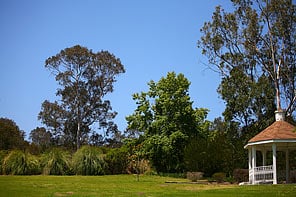 |
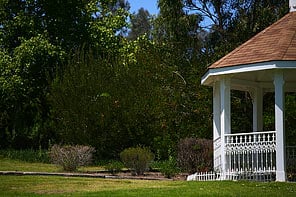 |
Full image, full-frame, at 70mm |
Full image, full-frame, at 200mm |
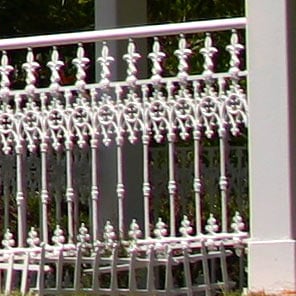 |
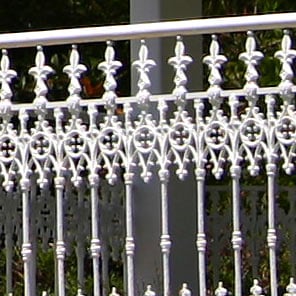 |
100% crop from 5D at 70mm |
100% crop from 5D at 100mm |
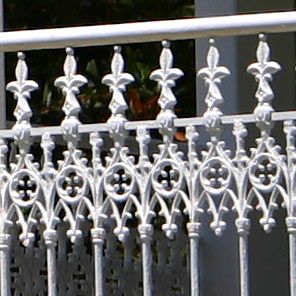 |
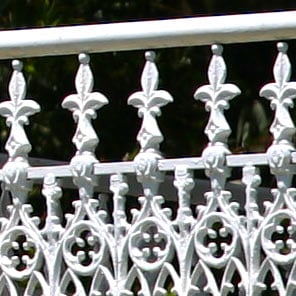 |
100% crop from 5D at 135mm |
100% crop from 5D at 200mm |
The crops have had no additional sharpening added. If you printed the full image at this magnification you'd have a print 44" (1.1m) wide. This is as good as I've ever seen, and this is wide open at f/4!
Color Rendition back to Performance or back to Introduction.
I see no differences from my other Canon lenses.
Construction and Materials Performance or Introduction.
It has a rubber gasket on the lens mount to keep crud out of your camera.
Filter Threads: Plastic.
Exterior Barrel: Plastic.
Front Ring on which "Canon Lens" is printed: Metal.
Focus Ring: Metal covered with a ribbed rubber band.
Zoom Ring: Metal covered with a ribbed rubber band.
Markings: Paint.
Switches: Plastic.
Mount: Metal.
Internals: Appear to be metal and plastic.
Noises when shaken: Moderate klunking. This is normal.
Made in: Japan.
Distortion back to Performance or back to Introduction.
The Canon 70-200mm f/4 L IS has typical distortion for this sort of zoom. It's trivial to correct in Photoshop CS2's lens distortion filter with the data I measured below, and DxO has a module for it.
Even easier, just shoot it at 100mm if you want zero distortion.
Here's the Wall of Shame:
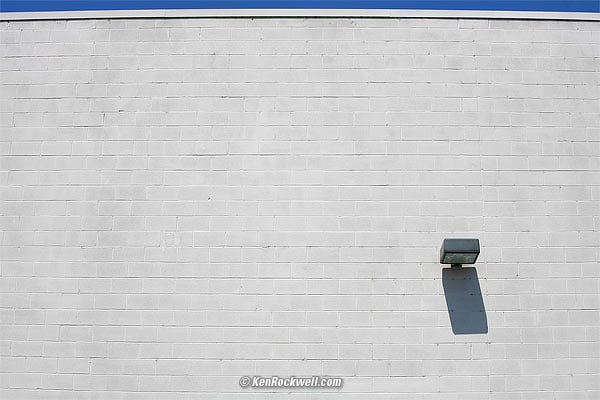
Canon 70-200mm f/4 IS at 70mm, full frame 5D.
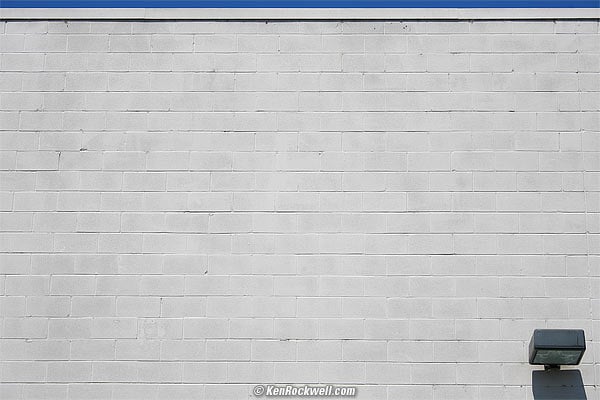
Canon 70-200mm f/4 IS at 100mm, full frame 5D.
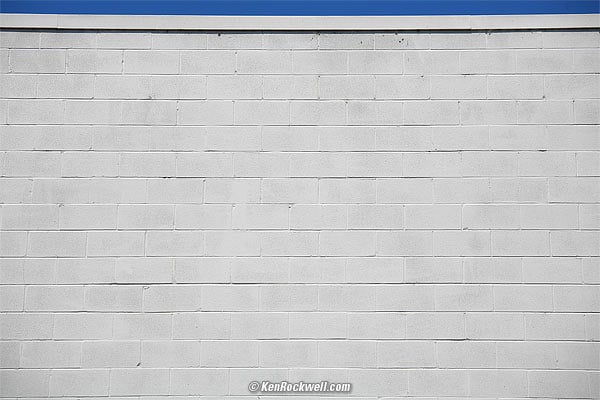
Canon 70-200mm f/4 IS at 135mm, full frame 5D.
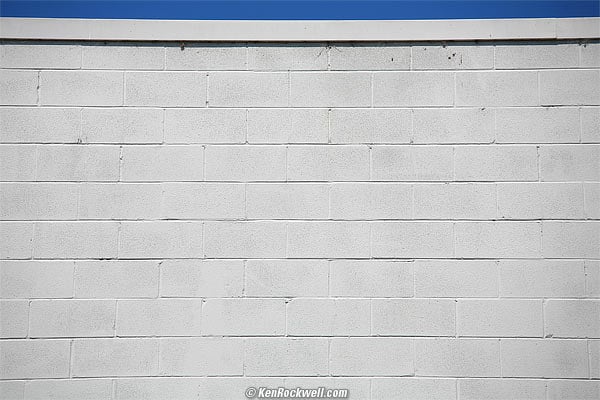
Canon 70-200mm f/4 IS at 200mm, full frame 5D.
Plug these figures into Photoshop CS2's lens distortion filter to correct the distortion. These figures are for you to enjoy in your photography. These took me hours to calculate and are all © and registered, so you'll need permission to use these figures for anything else like incorporating into software or your own books. Thanks! Ken.
10' (3m) |
50' (15m) |
Infinity |
|
70mm |
+2.3 |
+2.5 |
+2.7 |
100mm |
-0.5 |
0 |
0 |
135mm |
-2.0 |
-1.5 |
-1.6 |
200mm |
-2.5 |
-2.1 |
-3.5 |
Distortion is much less on smaller format cameras (see crop factor). Here are the numbers for these cameras, including the 20D and 30D. I'll spare you the boring wall photos.
at 10' (3m) |
at 50' (15m) |
|
70mm |
+1.0 |
+1.0 |
100mm |
+0.5 |
0 |
135mm |
-0.5 |
-0.5 |
200mm |
-0.7 |
-0.5 |
Ergonomics back to Performance or back to Introduction.
Excellent. The Canon 70-200mm f/4 L IS never gets in the way of great photos. Everything just works as it should. I can shoot and zoom with only one hand.
This is no small task, many other lenses like the 70-300mm DO IS have problems like balky zooms that require more work from me, or more hands, to make a picture. What might seem minor in a camera store grows to become a big pain, which is among the reasons I won't own a 70-300mm DO IS. The 70-200mm f/4 L IS has no problems; it just works.
Exposure Accuracy back to Performance or back to Introduction
I see no problems; everything is fine.
Eyeblow back to Performance or back to Introduction.
None. The rear element appears sealed, so no air blows in or out of the Canon 70-200mm f/4 IS as you zoom quickly.
Since it's also internal focusing, it is possible along with the weather sealing that this lens may be very well suited for use in dusty conditions, since unlike many other zooms it doesn't seem to suck air every time it's focused or zoomed.
back to Performance or back to Introduction.
Falloff performance is better than average. In actual shooting it's only visible at 200mm wide open. In fact, it seems that the f/4 IS lens wide open at f/4 is the same as the Canon 70-200mm f/2.8L IS stopped down a stop to f/4, and the f/4 lens is better than the f/2.8 lens with them both at f/5.6.
This is another good reason not to want to haul the huge f/2.8 version around; this smaller one has the same performance at any given aperture so you can use it at f/4 and not worry. Call up both of my reviews on your screen (if you're a digital photographer you deserve a 30" screen to make this stuff easy) and you'll see I shot them at slightly different exposures. Don't look at the absolute brightneses, look at the difference between center and corner.
There won't be any falloff visible on smaller format cameras, except maybe with a blank wall at 200mm at f/4 on a 1.3x camera (see crop factor).
Here are shots of an Expodisc. Shooting flat fields and laying them on another flat field is a tough test which exaggerates even the slightest falloff. You'll never see it this bad in normal photography.

